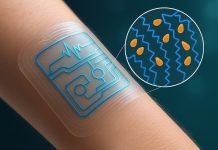
Laser technology has come a long way since its inception in the late 1990s.
One type of laser, called the ‘laser frequency comb’, has been crucial in precisely measuring frequency and time.
These lasers have found numerous uses in areas like super-accurate clocks, detailed chemical analysis, remote sensing, high-speed optical communication, and more.
However, a big problem has been how to use these lasers in systems that need to send lots of data at once.
This is because the strong light pulses from these lasers can cause heating problems.
This is not good when many small ring-shaped devices called ‘microring modulators’ are used together.
These devices are commonly used in a technique called ‘dense wavelength-division multiplexing’ (DWDM), which is a way to send lots of information down a single optical fiber.
Another challenge has been how to create a laser frequency comb that works across a broad range of light frequencies.
This requires careful control of something called ‘group velocity dispersion’ (GVD), which can be difficult because it mostly depends on the material that the laser is made from.
For laser frequency combs to be more widely used, their size, weight, power consumption, and cost need to be reduced.
But now, in a study published in ‘Light: Science & Applications’, a team of scientists led by Professor John Bowers from the University of California, Santa Barbara, has come up with an exciting solution.
They have developed a new type of laser based on ‘quantum-dot’ technology. This laser doesn’t produce strong light pulses, which makes it suitable for use in DWDM systems.
By using this new quantum-dot laser, they have created a laser frequency comb that works across a record-breaking range of frequencies and a channel spacing of 60 GHz.
This wide channel spacing helps to eliminate interference between channels in data transmission. Even better, this new type of laser is much smaller, more efficient, and uses less power than other lasers.
Quantum dots are very small particles that have some fantastic properties. They have incredibly fast gain dynamics, which allow for massive Kerr nonlinearity and four-wave mixing.
In simple terms, this means quantum dots are better for creating these frequency combs in the range used for optical communication.
What’s more, this new approach doesn’t require the careful engineering of the waveguide dispersion. Instead, it involves engineering Kerr nonlinearity, which is much simpler to control – just apply a voltage to a particular part of the laser. This makes the fabrication process a lot easier.
The scientists behind this work say, “This is an evolution of thinking.” They add that this technology is undergoing a revival, and they’re applying this new type of laser to high-speed photonic integrated circuits (PICs) used in data centers.
The new technique could be a game-changer, helping to overcome the challenges that laser frequency combs face on PICs.
What’s more, it’s compatible with the mature CMOS industry – the technology used to manufacture most microchips. This breakthrough could open a new avenue for the next generation of PICs for use in 5G/6G communication, artificial intelligence, and autonomous driving.
Follow us on Twitter for more articles about this topic.
Source: Chinese Academy of Sciences.



